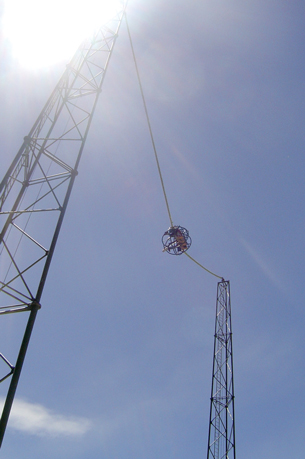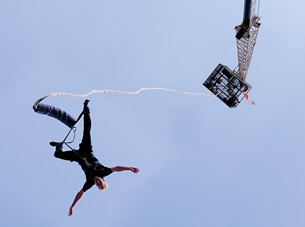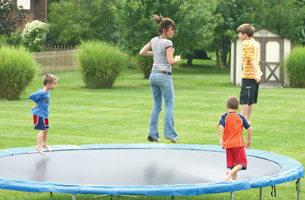Module 6—Work and Energy
 Reflect and Connect
Reflect and Connect

© Jonathan Noden-Wilkinson /shutterstock

© Adrian Steele/shutterstock
Bungee jumping is energy artwork—a periodic dance of energy transfers that repeats itself with each trip up and down. The jumper starts with gravitational potential energy at the platform, and then jumps, experiencing a free fall and a dramatic increase in kinetic energy with a similar decrease in potential energy. Once past the equilibrium position, the bungee cord absorbs the kinetic energy, converting it to elastic potential energy as the jumper approaches the lowest point, where the process reverses. On the way up, elastic potential energy becomes kinetic energy, which is then converted back to gravitational potential energy as the jumper approaches the maximum height. And then, it all reverses and repeats. The process does not continue forever because the bungee cord and jumper are an open system, letting energy out in the form of heat and sound.
Consider another thrill ride based on the same principles, but in reverse. On this ride, a cage is held up by several bungee cords. To start the ride, the cage is pulled down from a higher equilibrium position, a rider is loaded, and the cage is released, surging upward with a large acceleration.
Can you describe the energy transfers that occur on this ride and explain the observed acceleration?
Store your completed reflection in your Physics 20 course folder.
 Discuss
Discuss

© sonya etchison/shutterstock
Have you ever been on a trampoline? Trampolines are a potential source of fun, but they are also a potential source of injury. Have you ever been double-bounced on a trampoline? Imagine you are jumping on a trampoline, a process that is energetically similar to that of a bungee jump. Now, introduce a second person of equal mass who is also jumping up and down.
In the discussion forum, explain how one jumper could receive the energy of both jumpers, creating an opportunity for injury. Relate this to your own personal experiences on a trampoline, if possible.
For information about trampoline safety, research the Internet. There are trampoline safety tips at the Health Canada website.
 Reflect on the Big Picture
Reflect on the Big Picture
Each of the Reflect on the Big Picture sections in this module will ask you to consider gravitational, frictional, or elastic forces. To help you consolidate your learning from this lesson, complete at least one of the following activities.
- Think about your experiences to find examples of elastic forces that you have been involved with, such as archery, pogo sticks, paddle balls, bungee jumps, trampolines, and rubber bands. Prepare a short presentation about two or three of your experiences. Identify what work is done, and explain the transfer of energy that occurs in the activity. You can present it in writing, orally, or in a video or multimedia format.
- The bungee jump that introduced this lesson is a spectacular example of elastic and gravitational forces being applied simultaneously. Prepare and label a sequence of three or four illustrations showing the changes in gravitational potential energy, elastic potential energy, and kinetic energy as the bungee jumper falls from the platform to the jumper’s lowest point.
Store your completed reflection in your Physics 20 course folder.
Continue to complete your Unit C Assignment. Add to the KWL chart you worked on in Module 5. Store your updated chart in your Physics 20 course folder.
 Module 6: Lesson 1 Assignment
Module 6: Lesson 1 Assignment
Remember to submit the Module 6: Lesson 1 Assignment to your teacher.